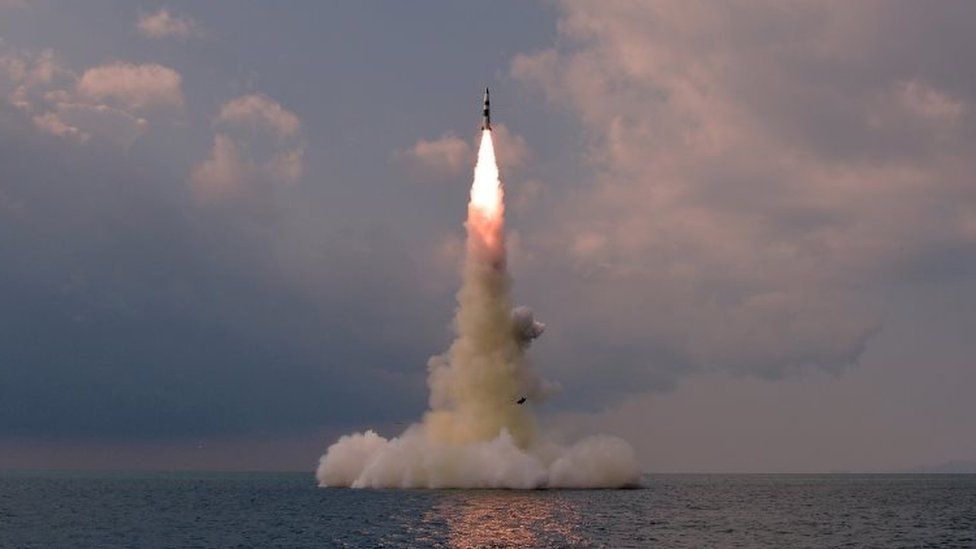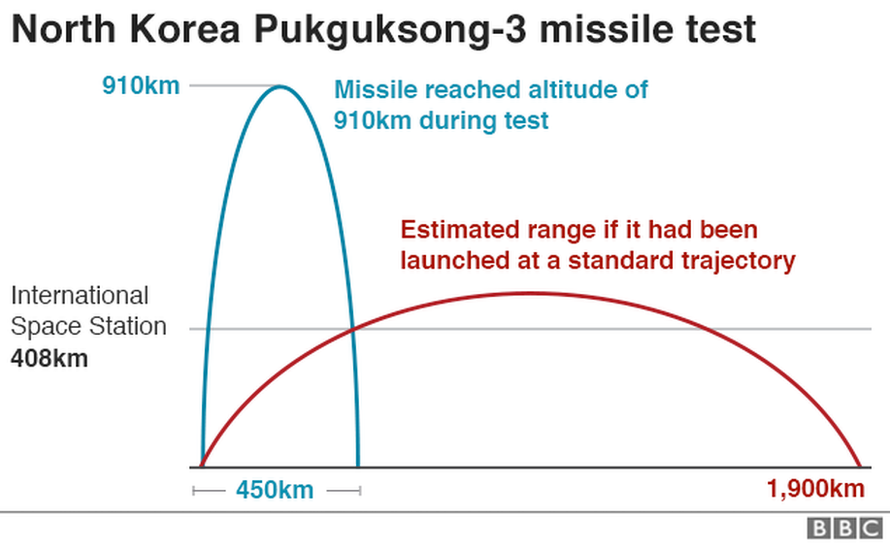
North Korea has successfully tested a new submarine-launched ballistic missile, state media say, confirming earlier reports by South Korea.
North Korea's KCNA news agency said the missile had "lots of advanced control guidance technologies", and was fired from the same vessel as in a 2016 test.
It did not mention leader Kim Jong-un, suggesting he did not attend the test.
On Tuesday, South Korea's military reported an apparent weapons test in waters off Japan's coast.
North Korea has carried out a flurry of missile tests in recent weeks, including of what it said were hypersonic and long-range weapons.
Some of these tests violate strict international sanctions.
The country is specifically prohibited by the United Nations from testing ballistic missiles as well as nuclear weapons.
The UN considers ballistic missiles to be more threatening than cruise missiles because they can carry more powerful payloads, have a longer range and can fly faster.
On Tuesday, South Korea's Joint Chiefs of Staff said one missile had been launched from the port of Sinpo, in the east of North Korea where Pyongyang usually bases its submarines. It landed in the East Sea, also known as the Sea of Japan.
They said it was suspected to have been a submarine-launched ballistic missile.
South Korean media reported that this particular missile was believed to have travelled about 450km (280 miles) at a maximum height of 60km.
Japanese Prime Minister Fumio Kishida on Tuesday said two ballistic missiles had been fired, calling the launches "very regrettable".
Why 'submarine-launched' is significant
In October 2019, North Korea tested a submarine-launched ballistic missile, firing a Pukguksong-3 from an underwater platform.
At the time, KCNA said it had been fired at a high angle to minimise the "external threat".
However, if the missile had been launched on a standard trajectory, instead of a vertical one, it could have travelled about 1,900km. That would have put all of South Korea and Japan within range.
Being launched from a submarine can also make missiles harder to detect and allow them to get closer to other targets.


The latest launch comes as South Korea develops its own weapons, in what observers say has turned into an arms race on the Korean peninsula.
Seoul is holding what is said to be South Korea's largest ever defence exhibition this week. It will reportedly unveil a new fighter jet as well as guided weapons like missiles. It is also due to launch its own space rocket soon.
North and South Korea technically remain at war as the Korean War, which split the peninsula into two countries and which saw the US backing the South, ended in 1953 with an armistice.
Kim Jong-un said last week that he did not wish for war to break out again. He said his country needed to continue developing weapons for self-defence against enemies, namely the US which he accused of hostility.


Meanwhile, South Korean, Japanese and US intelligence chiefs are meeting in Seoul to discuss North Korea.
The US envoy to North Korea, Sung Kim, is expected to discuss how to restart dialogue with Pyongyang, including on whether there should be a formal declaration of the end of the Korean War.
In the last 24 hours, he has reiterated the stance of US President Joe Biden's administration that it is open to meeting with North Korea without pre-conditions.
Previous talks between the US and North Korea broke down due to fundamental disagreements on denuclearisation.
The US wants North Korea to give up its nuclear weapons before sanctions can be eased, but North Korea has so far refused.
https://news.google.com/__i/rss/rd/articles/CBMiLmh0dHBzOi8vd3d3LmJiYy5jby51ay9uZXdzL3dvcmxkLWFzaWEtNTg5NzYxOTXSATJodHRwczovL3d3dy5iYmMuY28udWsvbmV3cy93b3JsZC1hc2lhLTU4OTc2MTk1LmFtcA?oc=5
2021-10-19 22:50:49Z
52781946223962
Tidak ada komentar:
Posting Komentar